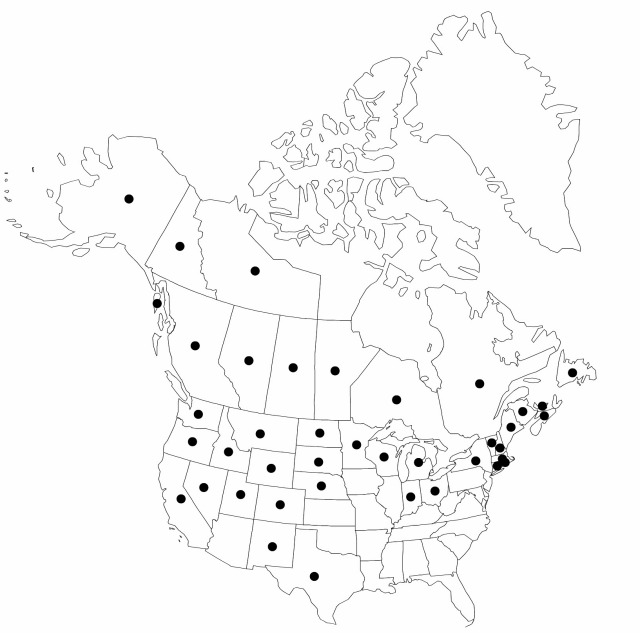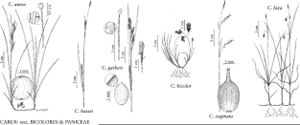Carex aurea
Gen. N. Amer. Pl. 2: 205. 1818.
Culms 5–40 cm. Leaves: blades 3–20 (–30) cm × 1.4–3 mm. Inflorescences: proximal bracts with well-developed blades exceeding inflorescence sheaths 2–4 (–10) mm; lateral spikes with 4–20 perigynia, approximate or proximal distant, lax, 4–20 (–30) × 3–5 mm, middle internodes (0.5–) 0.7–1.5 mm; terminal spike usually staminate, occasionally gynecandrous, sessile or short-pedunculate, 3–10 (–15) × 0.9–2 mm. Pistillate scales brown with paler or green midvein, divergent in mature fruit, ovate to ovate-circular, 1.2–2.5 × 1.1–1.8 mm, apex subacute to obtuse or cuspidate. Proximal staminate scales brown with paler or green midvein and hyaline margins, oblongovate, 2–3.5 (–4) mm, apex obtuse to subacute. Perigynia divergent, bright orange, somewhat inflated and fleshy when mature, circular-obovate, 2.3–3.2 × 1.2–1.8 mm, smooth or minutely papillose. Achenes subcircular, 1.4–1.8 × 1–1.5 mm. 2n = 52.
Phenology: Fruiting summer.
Habitat: Moist, open or shaded habitats, especially meadows and seepage slopes, usually on basic soils
Elevation: 0–3000 m
Distribution

Alta., B.C., Man., N.B., Nfld. and Labr. (Nfld.), N.W.T., N.S., Ont., P.E.I., Que., Sask., Yukon, Alaska, Calif., Colo., Conn., Idaho, Ind., Maine, Mass., Mich., Minn., Mont., Nebr., Nev., N.H., N.Mex., N.Y., N.Dak., Ohio, Oreg., R.I., S.Dak., Tex., Utah, Vt., Wash., Wis., Wyo.
Discussion
The orange perigynia of Carex aurea are unique in North American Carex. The color does not develop until the perigynia are fully mature and ready to be shed, hence most herbarium specimens do not show that feature.
Selected References
None.
Lower Taxa
"shortened" is not a number.
